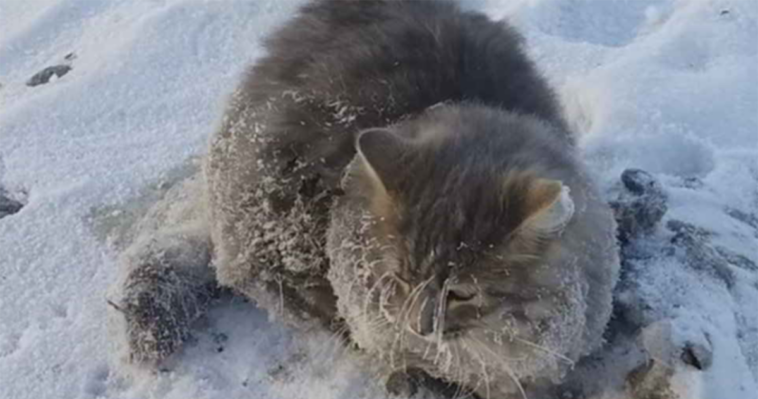While driving on a snowy and very cold day (-18 degrees), a man named Slava spotted something on the side of the road that intrigued him greatly. Indeed, a pretty cat of frozen hair stood there, without moving.
“I thought it was an animal and it should be frozen with that time,” Slava said. Unfortunately, many cars passed, but no one stopped. The man with a big heart then decided to act.
As she approached, Slava discovered in the snow a poor little frozen and unable to move, waiting for death without making any noise…
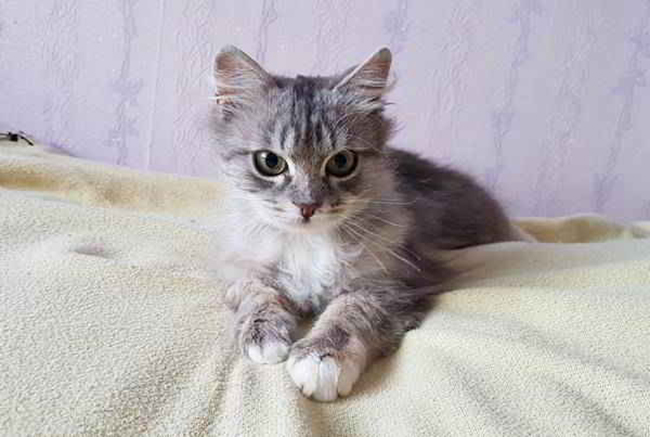
“It was very cold, so I wrapped it in a towel and took it back to my car. I turned on the heat to melt the frost on his coat,” Slava said.
The man with the big heart named the pretty cat Nika. He then drove the pretty cat to his father’s house where they prepared him a warm bed with several blankets, a radiator, and a lamp nearby.
Nika was so happy to be warm and safe that she purred like a truck engine and thanked her rescuers by rubbing her face against their hands.
The pretty cat had surely been lost and stuck in the snow, exhausted and unable to move because of the terrible cold. Slava then took the little feline to the vet where he learned that Nika was about 6 months old…
Her tail was so frozen that she had to be amputated. The operation went very well and little Nika, who is a real fighter, never knows how to let it down.
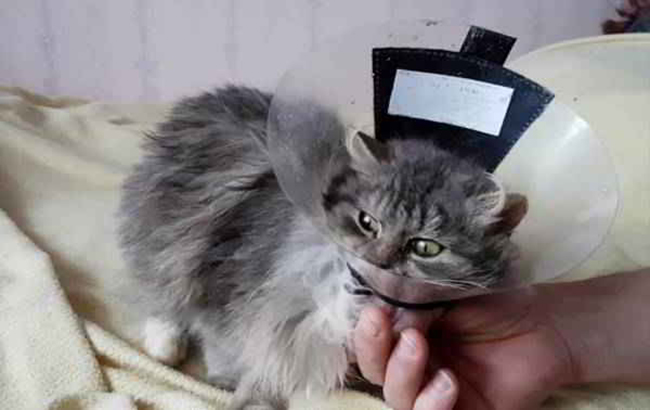
“She knew we were trying to help her. She was patient, didn’t complain and was very nice all the time. » Two weeks later, the pretty cat was back on all fours and showed her new human daddy her adorable personality.
“He’s an active cat who likes to play and run,” Slava said. Nika has just turned eight months and she enjoys a warm and loving life!…
Can a pretty cat get cold?
As the pretty cat is a homeothermic animal, it must maintain a roughly constant internal temperature to live. The normal temperature of a pretty cat is usually between 37.5 and 39.1 degrees Celsius, which is slightly more than a human being: this difference may seem insignificant, but it makes it naturally a little more resistant to cold than we do.
It also has and above all a major asset: its coat. Usually made up of a coat of cover and an undercoat, it provides very good protection against the cold.

On the one hand, it limits heat loss to the outside, and on the other, it prevents its skin from being wet or in direct contact with cold surfaces, for example, snow. Of course, the denser and tighter the coat, the more effective its protective role.
The fact that the small feline is often more resistant to the cold than humans does not mean that it cannot suffer from it, which some masters too often tend to forget. Thus, in some situations, even the thick fur of some breeds of long-haired cats like the Norwegian may not be enough.
Like humans, a cat can be cold in different situations: a low ambient temperature, a strong wind, a current of air, contact with a cold object or surface, a wet coat, etc.
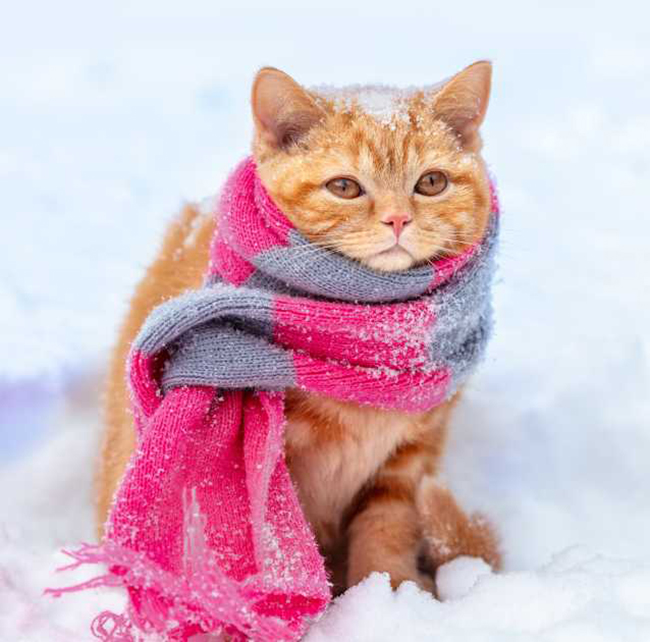
He may then start shivering, trembling, or shivering. His first instinct is often to try to take shelter or to find a source of heat to warm up.
The risks of cold for the cat
The cat is a warm-blooded animal that generally needs a stable body temperature to survive. When it starts to get cold, for whatever reason, it tries to warm up with reflex movements, such as chills or goosebumps (which is much more effective at warming up in animals with coats than in humans).
In case of inclement weather, he can also instinctively seek shelter, and if his coat or pads are wet, wash and dry them. If it is in contact with a cold surface or object, it is looking for a source of heat.
But if the cat fails to warm up, because it is unable to take shelter and/or the temperatures are too low for its body, it is exposed to several risks to its health…
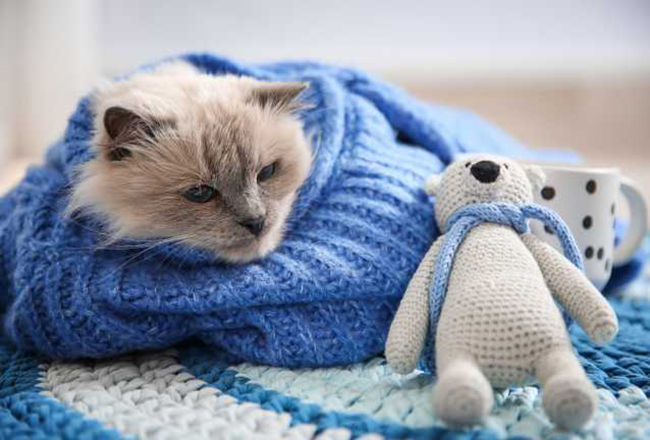
How do I know my kitty cat’s cold?
As in humans, certain signs and attitudes can help to recognize that a cat is cold.
When the cat suffers from mild hypothermia, i.e. its body temperature is simply slightly lower than normal, the cat is generally agitated and trembling, or even shivering. Its heart beats faster, and the end of its limbs becomes painful because it is less well oxygenated.
He looks for a source of heat (radiator, fireplace, heated floor, etc.) or cloth in which to curl up to warm up.
In the case of intermediate hypothermia, the cat is prostrate, its skin becomes icy and its mucous membranes pale. He breathes irregularly and his heart rate is much slower, which puts him at risk of bradycardia (i.e. an abnormally low heart rate, which results in a lack of energy, abnormal shortness of breath, or even discomfort).

Finally, when hypothermia is severe, breathing and heartbeat decrease considerably, to the point that it can eventually fall into a coma. Death eventually occurs through cardiac arrest or respiratory arrest.
Unfortunately, when a cat feels unwell or vulnerable, for example when it is in a situation of hypothermia, it may have the reflex to hide out of sight. His master is not always able to realize his state of health.
It is, therefore, necessary to try to ensure that his little feline is in top shape, especially when in winter he comes back from a long walk in the cold or even snow.
If in doubt, it is better to take your temperature with a thermometer specially designed for this purpose: it is the best way to be fixed and to be able to intervene if necessary.
What if my pretty cat is cold?
Most of the time, a cold cat manages to find a way to warm up on its own.
But it is still better to help him to find an optimal temperature because if the situation continues, he can be the victim of hypothermia, which can cause a very rapid deterioration of his health.
In case of mild symptoms
If the cat shows only signs of mild hypothermia, i.e. simply tremors and possibly frostbite, it is not very difficult to help.
In many cases, a soft cushion, a plaid, or even a cat hammock installed near the radiator are more than enough to allow it to return to its usual temperature. There are also thermal blankets that, when plugged in, emit controlled heat up to 10oC above room temperature.
Few owners know this, but brushing your cat’s coat also helps her body return to normal temperature.
Indeed, once put in order, the hair is more insulating and retains better body heat. If the fur is wet, it should be dried gently with a towel.

If the animal suffers from frostbite, it is recommended to apply lukewarm compresses on it, or even soak it directly in lukewarm water to help restore blood circulation.
Just be careful not to rub it so as not to irritate or even flak the skin (i.e. make it produce dander), and not to put it in contact with water, or hot water or compresses, at the risk of making the burn worse.
Once the circulation gradually resumes, i.e. the skin regains its usual pink color, it must be dried and covered with a non-stick bandage, again to avoid peeling.
In the case of pronounced symptoms
If the pretty cat suffers from severe frostbite or hypothermia, i.e. if its heart rate and breathing are slowed, it is an emergency. You should contact a veterinarian immediately, describe the situation, and follow his instructions.
There is a good chance that he will ask the owner to bring the animal to him without delay so that he can be properly warmed up and kept under observation while his condition is stabilized.
It may also look for an underlying cause, as hypothermia is not necessarily caused by low temperatures: it can also be caused by a serious health problem, such as feline panleukopenia or internal bleeding.
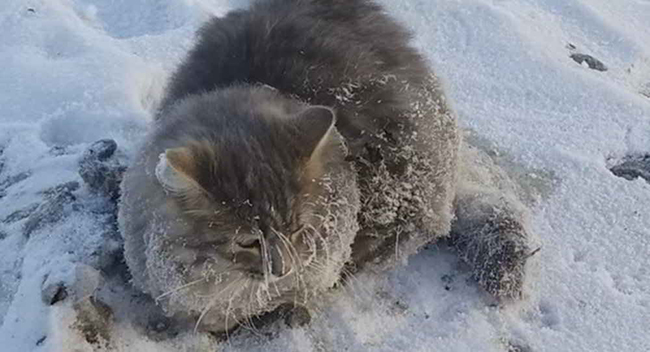
To warm it up, the veterinarian does a very similar procedure to the case of mild hypothermia: he places it in a warm room, surrounds it in warm blankets, and takes its temperature every ten minutes to make sure it gradually warms up.
It can also give infusions of the hot liquid to warm it from the inside. At the same time, if the animal suffers from frostbite, it examines them to determine if amputation is necessary.
In any event, the faster the master reacts when symptoms indicate that his cat is cold, the lower the risk of reaching such an extreme.
On the off chance that you thought this story was inspiring, send it to a relative or companion who needs to see it.

